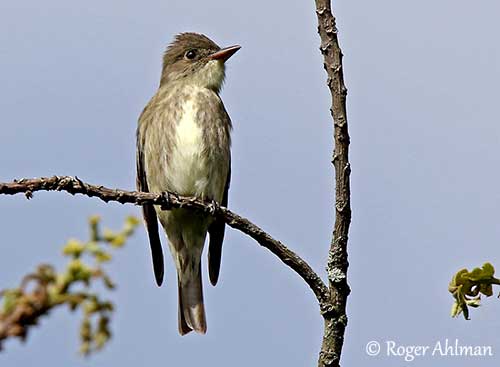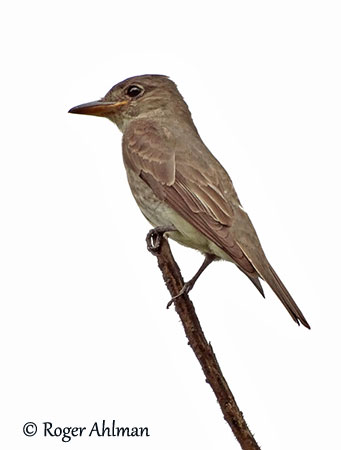
Fr: Moucherolle à côtés olive
Ang: Olive-sided Flycatcher
All: Olivflanken-Schnäppertyrann
Esp: Pibí Boreal
Ita: Pigliamosche fianchioliva
Nd: Sparrenpiewie
Sd: nordlig pivi
Photographers:
Roger Ahlman
Pbase Galleries Peru and Ecuador
Tom Grey
Tom Grey's Bird Pictures & Tom Grey's Bird Pictures 2
Text by Nicole Bouglouan
Sources:
HANDBOOK OF THE BIRDS OF THE WORLD Vol 9 - by Josep del Hoyo - Andrew Elliot - David Christie - Lynx Edicions - ISBN: 8487334695
BIRDS OF THE GREAT BASIN – by Fred A. Ryser, Jr - University of Nevada Press -ISBN: 0874170796
South Dakota Birds and Birding – (Terry L. Sohl)
Bird Web (Seattle Audubon Society)
The Northwest Territories (NWT) Species at Risk
Olive-sided Flycatcher Migration & Breeding
What Bird-The ultimate Bird Guide (Mitchell Waite)
Wikipedia, the free encyclopaedia
Olive-sided Flycatcher
Contopus cooperi
Passeriformes Order – Tyrannidae Family
INTRODUCTION:
The Olive-sided Flycatcher breeds in coniferous forest of North America, from N Alaska across Canada, with extensions southwards into the USA. This long-distance migrant spends the winter in Central America and a large northern part of South America.
It is a compact, big-headed flycatcher often seen perched upright on high branch in tree while singing. If feeds mainly on insects caught by sallying and returning to the same perch. The male performs aerial displays at the beginning of the breeding season. The cup-shaped nest is built in tree, mainly in conifer.
The Olive-sided Flycatcher is threatened by loss and degradation of the forest habitat on both breeding and wintering grounds, but also during migration.
The species is currently listed as Near Threatened.

DESCRIPTION OF THE BIRD:
Biometrics:
Length: 18-20 cm
Wingspan: 33 cm
Weight: 29-35 g
The Olive-sided Flycatcher has deep olive-grey to brownish-olive head and upperparts. The upperwing is dusky with indistinct greyish wingbar. Inner secondary and tertial flight-feathers have whitish edges. There is a white tuft on each side of the rump, often hidden by the wing. The tail is dusky.
The underparts, throat, breast and belly are dull white to yellowish, whereas body sides and flanks are streaked/mottled dusky olive, giving the bird the appearance of wearing an unbuttoned vest (Altman & Sallabanks). The undertail-coverts show dull, brownish-grey feather centres.
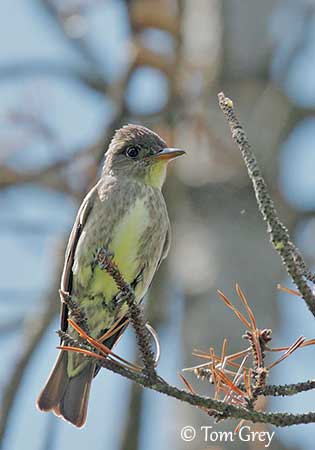
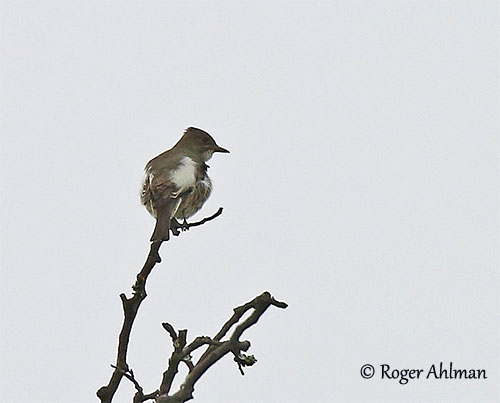
The head is like the upperparts with a peaked crest (sometimes flattened).
The broad, two-tone bill has black upper mandible and yellow/pale orange lower mandible with dark tip. The eyes are dark brown. Legs and feet are black.
Male and female are similar.
The juvenile resembles adult but it is browner overall. Wingbars and edges of tertials are washed buff.
DISTRIBUTION GEOGRAPHIQUE:
The Olive-sided Flycatcher breeds from N and W Alaska, E across C Canada to Maritime Provinces, and also S in the USA to N California, locally into NW Mexico (Baja California). In the interior, it breeds through Idaho and W Montana to NE Arizona, NW New Mexico and W Texas. In the E, it breeds to the boreal regions of Adirondacks and New England, S to Appalachian Mountains.
It moves over long distances to spend the winter locally in W and S Mexico, S to Panama and from Colombia and Venezuela, S to SE Peru and NW Bolivia, and also in Ecuador. It can be found locally in the Guianas, S Amazonia and SE Brazil.
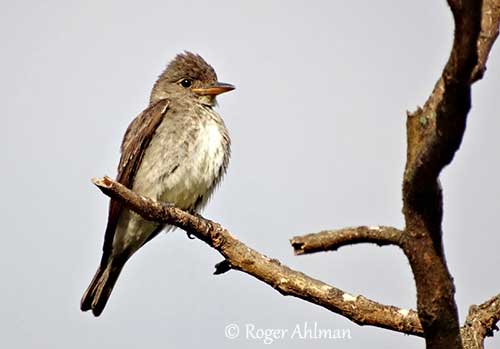
HABITAT:
The Olive-sided Flycatcher breeds mainly in openings and edges of coniferous forests. It has adapted to logging and fires if snags and residual trees remain to provide perches and foraging places. It also occurs at high densities in burned areas in inland pine forests. The species also breeds in moist, coastal forests, along streams and shorelines where it finds numerous insects. In the boreal zone, it also frequents bogs and swamps. It breeds from sea-level to 3,350 metres of elevation.
On migration, it frequents riparian and non-coniferous habitats, mainly in mountains.
During winter, it is present in evergreen forest at mid-elevation, especially in openings and edges where snags are present, between 400 and 3,400 metres.
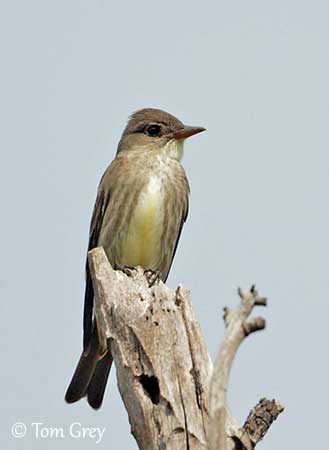
CALLS AND SONGS: SOUNDS BY XENO-CANTO
The Olive-sided Flycatcher’s call is a “pip,pip,pip” or “bik,bik,bik” including three spaced hard notes. This call is given by both male and female all year round. Near the nest, both mates give twittering “pip”-like notes. The male also utters a short song-call combination “peer-pip”, and we can hear a squeaky “eek” during attacks against predators. They also perform bill-snapping.
The song is given from very high perches, and mainly early in the morning and in the evening. There are three syllables in the song. The first syllable is short, sharp and not very loud, whereas the two following syllables are loud and strongly accented. This penetrating whistle is described as “whit, whee-pew” or “whip wéédééér” also known as “quick, three beers”. This readily identifiable bird song makes this species a favorite of birders.
However, the calls of the Pacific birds vary slightly “what peeved yoou” with no syllable emphasized.
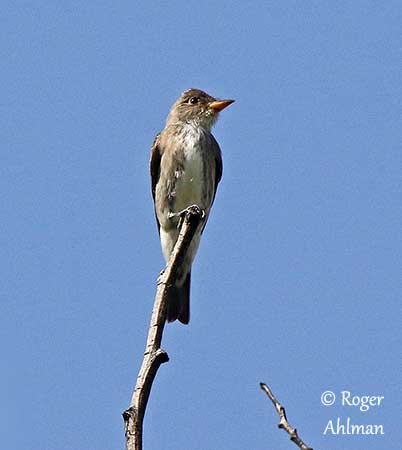
BEHAVIOUR IN THE WILD:
The Olive-sided Flycatcher feeds mainly on flying insects and especially bees and wasps, but also ants, flies, moths, grasshoppers, dragonflies and beetles.
It typically hunts like all Tyrannidae by waiting quietly from exposed perches and sallying out to catch the prey in the air, before to return to the same perch. The small prey are eaten in flight, but the larger items are carried back to the perch and sometimes hit against the perch before to consume them.
In Alaska, birds foraging near the ground are reported.
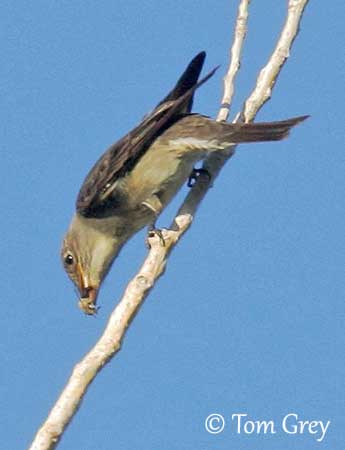
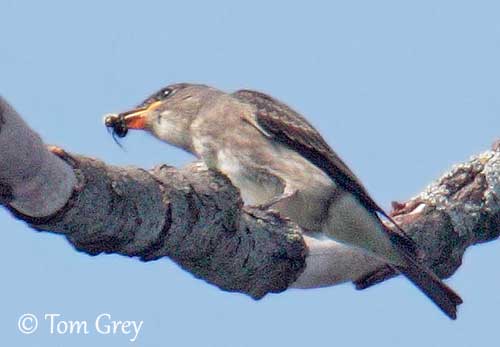
During the breeding season, the male defends the territory by singing continuously. The courtship displays are poorly known, but they probably involve active chasings through the treetops.
But some observations describe interesting flight displays.
In the first display, two birds (sexes unknown) engaged in a mutual pendulum display while performing bill-snapping. The two birds flew back and forth in an arc parallel to each other. This flight was repeated 3-4 times before going to two different perches. This display was repeated several times, between 14 and 17 metres above the ground.
The Olive-sided Flycatcher is a long-distance migrant. The birds breeding in Alaska perform a remarkable 20,500 annual journey, with adults wintering as far as Bolivia. They migrate at night.
They leave the breeding grounds between early August and early September and arrive in South America in October/November. They leave the wintering grounds in late March/April and arrive on their breeding grounds from April to late May.
The Olive-sided Flycatcher has swift, direct flight with rapid wingbeats.
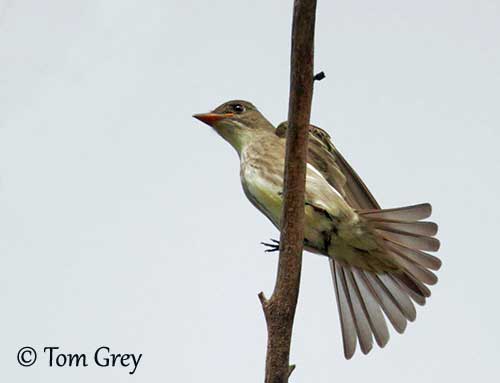
REPRODUCTION OF THIS SPECIES:
The breeding season takes place between May and August.
The female builds a cup-shaped nest, usually placed towards the tip of horizontal branch well out from the trunk in conifer, although deciduous trees are also used depending on the range. The nest is made with twigs, grass and weeds, and the cup is lined with lichen, grass and pine needles.
The female lays 3-4 pinkish-buff eggs with brown and grey spots. She incubates alone during 14-17 days. Both parents feed the chicks that fledge between 15 and 23 days after hatching, with the first flight at about 21-23 days of age.
PROTECTION / THREATS / STATUS:
The Olive-sided Flycatcher is threatened by degradation and loss of the habitat caused by human activities, involving reduction of food sources and increasing numbers of predators. However, the species is able to adapt to several types of harvested forest, fairly similar to its preferred post-forest fire habitat mosaics.
On the wintering grounds, the tropical deforestation has also a negative impact.
The population of this species has undergone a significant decrease over the last 40 years in North America.
Currently, the Olive-sided Flycatcher is listed as Near Threatened.
